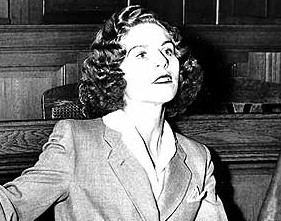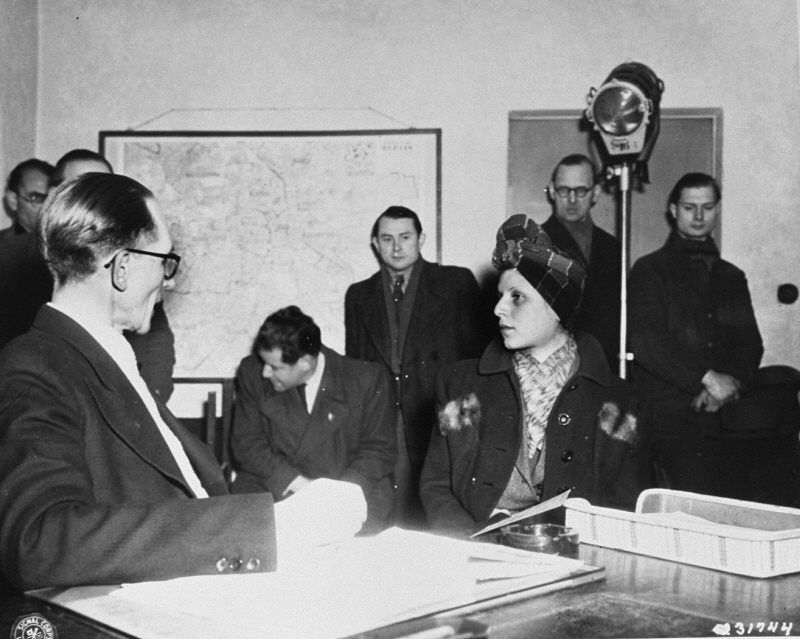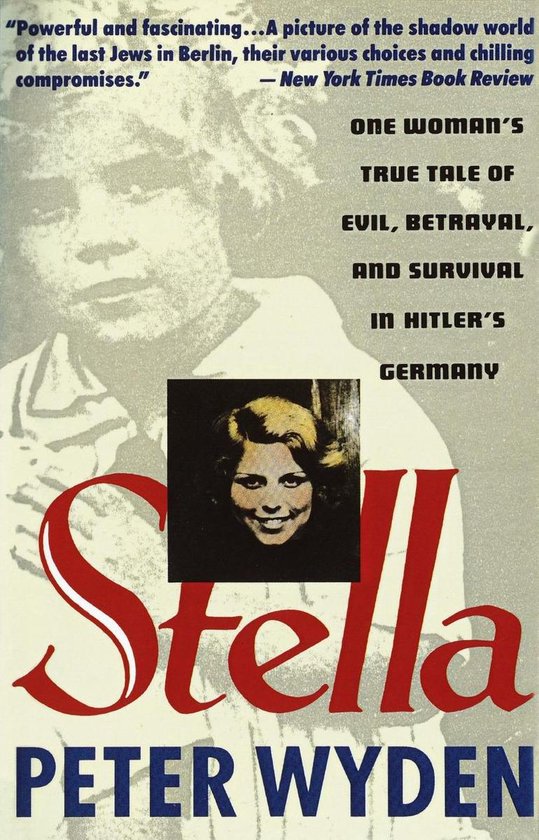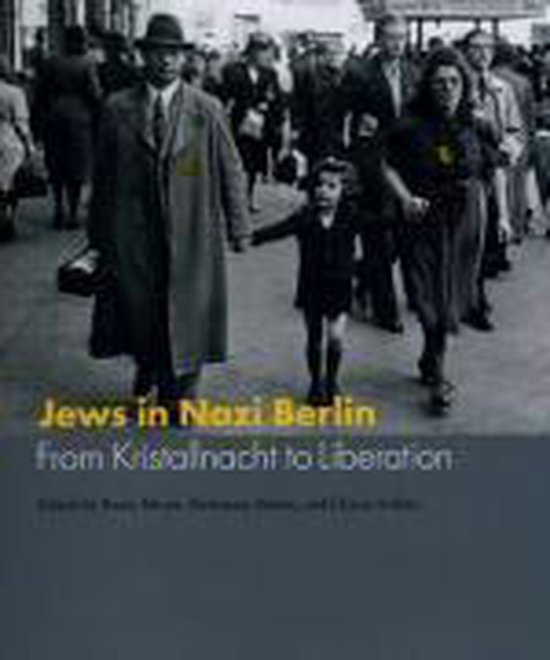Stella Goldschlag
Introduction
She was young, attractive, well dressed and lacked no male attention. The only thing working against blond beauty Stella Goldschlag was her ancestry. During her teens, she and her parents physically experienced the anti-Semitism of the Nazis in Berlin. During the war, deportation loomed for the entire family but in order to avoid that, Stella took a decision for which she would have to atone after the war. She went to work for the Gestapo and in this role, she and her partner and later husband Rolf, were responsible for hunting down and arresting probably hundreds of Jews who were subsequently deported to the concentration and extermination camps. She was the scare of every Jew in hiding in the German capital and in post-war Germany, she evolved into the embodiment of the ultimate evil.
Childhood years and anti-Semitism
Stella Goldschlag was born July 10, 1922 in Berlin, the only child of Gerhard Goldschlag and his wife Toni. Although the Goldschlag family did celebrate the important Jewish holidays, they were fully integrated in German society. During the First World War, her father had fought in the German Imperial Army and considered himself a Prussian first and foremost. Hence it must have been hard on him to be forced to quit his job in the Berlin office of a French newsreel producer in 1935, due to his Jewish ancestry. Subsequently he tried to make a career for himself as a composer but here also, his possibilities as a Jew were limited. He was forced by the Kulturbund, a relief organization for Jews who had been victimized by the exclusion from employed, established by Jewish artisans in July 1933, to concentrate on Jewish music while it was German music he loved so dearly. In the same year of his discharge, his daughter was likewise confronted with the anti-Semitism of the new rulers. Although she, just like her father, felt to be a German above all and although she could pass for an Aryan because of het blue eyes and blond hair, she was expelled from public secondary school for her Jewish ancestry. She was forced to continue her education at a private Jewish school in the Berlin suburb of Grünewald, for which she was granted a scholarship due to the poverty of her parents.
At the Jewish school Stella, always stylishly dressed and with her pretty looks made a profound impression on her fellow students. She had matured early and with her stories about sexuality, she made the boys go wild and managed to enthrall the shy girls. After the war, fellow students compared her to Hollywood star Marilyn Monroe. A life full of glitter and glamour was a far cry however from the daily reality of Stella and her parents, members of a minority that was increasingly stripped from its rights. During the pogroms of Kristallnacht, Stella's father had evaded violence and arrest by going into hiding temporarily but subsequently he decided the time had come for him, his wife and his daughter to leave the country. At that point in time, this was very difficult without money or influence. While the international community was well aware of the discriminating measures against the Jews and Kristallnacht was condemned worldwide, almost all countries imposed strict immigration quota, including the United States. Gerhard Goldschlag was told at the American consulate it would take about two years before his family would be welcome over there. Other attempts at emigration also failed and the Goldschlags were left with no other choice than to remain in Germany.
First years of the war
In the year 1939, when war broke out, Stella managed despite everything to work on her future and have fun. She studied at a Jewish art academy, attending college for two years with the intention to become a fashion designer. In her spare time, she sang in a Jewish jazz band. She was also lucky in love, marrying the leader of the band, Manfred Kübler in October 1941. She could not escape anti-Semitism however. Like other Jews, in September 1941, she was forced to wear the Star of David and in the same year, she was forced to work in the war industry which meant exemption from deportation for the time being. Initially she was employed in a Siemens factory where electric engines were produced and later on she worked in an ammunition plant. She wore her star only at work enabling her to move about freely after hours doing whatever she wanted. Even during the so-called Fabrikaktion in February 1943, during which all Jews still remaining in Berlin shops and factories, luck was with her and she succeeded in evading arrest. Along with her mother, who worked in the same factory, they easily managed to pass as non-Jewish workers during the round-up, thanks to their blond hair and blue eyes. Stella's husband Manfred did not succeed in staying out of Nazi hands though; he was picked up during a round-up and deported to Auschwitz where he probably perished.
Following the Fabrikaktion, Stella and her parents went into hiding. Forger Günther Rogoff, a fellow student of Stella at the art academy, produced identification papers for her so she would not have to remain in hiding all the time. She had not lost her sex-appeal yet and on a spring day in 1943, while waiting in line for a shop, she met opera actor Rolf Isaaksohn who was to become her second husband in 1944. Like her, he was of Jewish ancestry but because of his good looks, he could easily be mistaken for an Italian, which enabled him to move about in public relatively freely as well. Charming Rolf and appealing Stella made an attractive couple. Their early happiness ended abruptly on July 2, 1943. When Stella was waiting in a pub for her lover, she was spotted by an acquaintance, Inge Lustig. This Jewish woman was a so-called Greifer (catcher) assisting the Gestapo in tracking down and arresting Jews in hiding. There was no way Stella could escape and she was apprehended by the Gestapo agents accompanying Inge. She was taken to the Gestapo office at 26 Burgstrasse where she was brutally interrogated in a cell in the basement. Her interrogators had discovered her forged ID papers had been the work of Günther Rogoff and they wanted to know the whereabouts of this fugitive forger from Stella. She was kicked and beaten and threatened with a gun but because she really knew nothing about Rogoff's whereabouts, she could not provide her henchmen with useful information.
After her captors had concluded she could or would not divulge anything, she was transferred to the prison for women at the Bessemerstrasse, near Tempelhof airport. She remained in her filthy cell for only a few days as she managed to escape during a visit to a dentist outside the prison, for which she had received permission, complaining about an urgent dental problem. Once back in the outside world, she was reunited with her parents who had gone into hiding in the meantime. The three of them found shelter in a pension on the Kaiserallee, today the Bundesallee in the western part of Berlin. She could enjoy her newly won freedom for a short while only as less than half a day after her escape she was arrested by the Gestapo again. This time her parents were arrested as well. As they were not important for the Gestapo, they were taken to the transfer camp on Grosse Hamburgerstrasse 26. Stella herself was interrogated once more in the prison on Bessemerstrasse as the Gestapo was still, incorrectly, convinced she could help in localizing the forger Rogoff. When the prison building was hit by bombs on August 23, 1943, during a massive British bombardment, the heaviest so far, wide spread panic broke out among the prisoners. While numerous women perished in the flames, Stella managed to escape however. She was free once again.
Collaboration with the Gestapo
Instead of fleeing, Stella decided to report voluntarily to the transit camp on Grosse Hamburgerstrasse 26 after her second escape. She did so out of love for her parents who were still staying here. Since her youth, she had depended on them heavily and a future without them at her side was unthinkable for Stella. The Gestapo still clung to the assumption she knew the whereabouts of Rogoff and she was questioned again. This time she was put under more pressure. If she would not cooperate in tracking down the forger, she and her parents would be put on transport to Auschwitz. Stella therefore pretended to possess useful information about Rogoff and along with two other Jewish collaborators of the Gestapo, she set out to hunt him down. After her two companions had found out, she knew nothing at all she was placed as yet on the transport list to Auschwitz along with her parents. Meanwhile, her lover Rolf had been arrested by the Gestapo as well and recruited to help arrest Jewish hiders. Stella also received the offer to collaborate with the Gestapo. In exchange, she and her parents would not be deported. She accepted the devilish offer, a decision she was to regret until her death after the war.
After being trained by the Gestapo, Stella and Rolf became members of the Jüdischer Fahndungsdienst (unit for tracking down Jews), consisting of some 20 young men and women known as Greifer (catcher). They were granted a bounty of 200 Reichsmark for every Jew in hiding who was arrested with their help. Carrying a gun and papers identifying them as Gestapo agents, they were free to move about the city without having to wear a Star of David. Initially, the Greifer HQ was located in the transit camp at Grosse Hamburgerstrasse and later on in the pathology wing of the Jewish hospital. The bounty hunters were housed in separate rooms and had no shortage of food. Former policeman Walter Dobberke, who had entered service with the Gestapo in the rank of SS-Hauptscharführer and commander of the transit camp, was in command of the tracing unit. Stella and Rolf were probably his most successful and in any case his most notorious collaborators. They often operated together but also hunted down Jews in hiding on their own.
The blond venom
Her attractiveness towards men and good memory for names made Stella very suitable as Greifer. The same applied to Rolf, who was described by witnesses as unscrupulous and violent. Wearing his long leather coat and trilby hat, he looked like a real Gestapo man. Stella and Rolf often operated in places of entertainment still visited by Jews who escaped temporarily from the boredom or tension of their daily existence in hiding. Stella and Rolf knew many of these fugitives by name or face. While Rolf often threatened his victims with a gun and applied violence before handing them over to the Gestapo, Stella's methods were more subtle. Her pretty looks made her a tempting bait. One of her male victims, who survived the war as he had managed to escape from the train to Auschwitz, recalled how Stella had accosted him one day and asked for his help. Life in hiding was apparently hard on her and she was hungry. The man was willing to help and took her to a pub where he was led into a trap and arrested by Dobberke's agents. Stella's hunting grounds also included cemeteries. After Jewish men or women had buried their non-Jewish spouse or husband, Stella was ready to hand over the Jews, no longer privileged by their marriage, to the Gestapo.
It is not clear how many Jews have been picked up with the help of Stella and Rolf but possibly hundreds. Stella in particular was widely feared within the community of hiders. "She had the reputation of being able to smell out hidden Jews and defectors," according to Holocaust survivor Inge Deutschkron. During and after the war she was hated by Jews anywhere and evolved into the embodiment of evil. After the war, the press paid much attention to her activities during the war. The papers called her "the blond witch" or "the blond venom." On occasion of a legal procedure against her in October 1957, the headline of a tabloid in West-Berlin read: "Jewess sent all of her friends to the gas chambers."
Downfall
Stella's downfall came after the war. She suffered her first defeat in February 1944 though. Despite her protests to commander Dobberke, her parents were put on a transport nonetheless. Not to Auschwitz-Birkenau but to Theresienstadt in Czechoslovakia. They would remain there until October. In order to help her parents get through the difficult times, she sent them bread. She received a post card from both her father and mother from the camp. In October, contact was broken. That month, Gerhard and Toni Goldschlag were transferred from Theresienstadt to Auschwitz-Birkenau where they both were murdered. Meanwhile, quarrels and serious rows frequently erupted between Rolf and Stella who was sometimes beaten by her lover. As commander Dobberke feared they would grow further apart, causing him to lose control over the successful hunting couple, he forced them to marry one another. Consequently, on October 29, 1944, Rolf and Stella got married. Dobberke had hoped marriage would bring about stability and that Rolf as a husband would have more influence on Stella. This turned out not to be the case though. The period in which the loving couple successfully hunted down hiders came to a definitive end in the spring of that year.
Rolf and Stella had become alienated sexually and both entered extramarital relations. In February 1945, Stella became pregnant, probably by Heino Meisl, a fugitive who had been caught by Greifer in September 1944 and had landed in the hospital of the transit camp. Due to doubts about his origins (he himself claimed he was only a half Jew) and because rumors circulated he had influential connections within the Nazi leadership, he had not been put on transport yet. A happy life with her new lover and father of her child was not to be however. Although he survived the war, he would never meet his daughter Yvonne who had been born in October. The girl was born in Liebenwalde, a village north of Berlin where pregnant Stella had gone into hiding in the last months of the war to stay out of the hands of both the Nazis and the Red Army that had launched its attack on Berlin on April 16, 1945. Berlin fell to the Russians on May 2, 1945 and the Third Reich came to an end. Stella was arrested by the local police and her child was taken away from her. Yvonne was handed over to a nurse and later on was taken in by foster parents. Stella would never get her back.
After the war
Following her arrest, Stella initially managed to convince the police she was a victim of the Nazis. When she was transferred to the Jewish Community in Berlin for identification, her cover was blown though. To the Jewish survivors in Berlin, Stella was a notion, the embodiment of evil. After members of the Jewish Community had shaved her head and called her names, she was transferred to the police station, controlled by Soviet authorities, on Alexanderplatz. After having been interrogated, she was brought before a Soviet tribunal. The three judges needed only minutes to sentence her to 10 years hard labor. She spent two years of her imprisonment in former Nazi concentration camp Sachsenhausen and the remaining 8 years in the prisons of Torgau and later in Hoheneck, both in the Soviet zone of occupation, which was to become the DDR. Prior to her release, she was admitted to the prison hospital in Waldheim, Saxony with tuberculosis. Not yet entirely recuperated from her illness, she ended up in West-Berlin after her release, where she hoped to be reunited with her daughter and to start a new life in freedom. Both hopes were in vain. Despite numerous attempts to regain custody of her daughter, she did not succeed. Even when her daughter Yvonne had become an adult, she refused contact with her mother, hated by so many. Moreover, a year after her release from Soviet imprisonment, she was indicted again, this time by the West-German authorities in Berlin.
The second trial against Stella started on June 20, 1957 in West-Berlin with massive attention from the media. She was charged with complicity in the murder of an unknown number of people, probably a few hundred. The trial took four days. The public prosecutor called a number of witnesses who depicted Stella as a ruthless criminal. Prior to the trial, a psychiatrist had diagnosed her as a schizophrenic psychopath. Stella herself tried to evoke pity by pointing to her bad health and telling about her sorrow over the loss of her child. She denied all charges and considered herself a victim of the times. In her opinion, the trial was a Jewish conspiracy against her: Jews would always have been jealous of her pretty looks. Up to a point, the court could understand her collaboration with the Nazis in order to save her parents from deportation but condemned the drive and scope of her activities which she had even continued after her parents were deported. Although the prosecution had demanded 15 years imprisonment, Stella was sentenced to 10. As she had already been incarcerated for 10 years in the Soviet zone of occupation she did not have to go to jail again. During a second trial against her in 1972, the West-Berlin court did not arrive at a different sentence.
Stella would marry three times until her death. She spent the last years of her life in loneliness. Her daughter had emigrated to Israel where she worked as a nurse. Stella spent her days watching television, was depressive and could only fall asleep using pills. In 1994, the woman feared so much by Jewish hiders committed suicide at the age of 72, by jumping out of the window of her Berlin apartment. The post-war fate of Rolf Isaaksohn, her second husband with whom she had hunted down Jewish hiders is unknown. Despite the fact the Berlin police had issued a search warrant for him soon after the war, he would never be tracked down and called to atone for his acts.
Definitielijst
- Auschwitz-Birkenau
- The largest German concentration camp, located in Poland. Liberated on 26 January 1945. An estimated 1,1 million people, mainly Jews, perished here mainly in the gas chambers.
- collaboration
- Cooperation of the people with the occupying forces, more generally spoken the term for individuals who cooperate with the occupying force is collaborator.
- concentration camp
- Closed camp where people are being held captive that are considered to be anti- social, enemies of the state, criminal or unwanted individuals. These groups mostly do not get a fair trial or are condemned to doing time in a camp.
- First World War
- Took place from 1914 till 1918 and is also named The Great War. The conflict started because of increased nationalism, militarism and neo-colonialism in Europe. Two alliances battled one another during the 4-year war, which after a dynamic start, resulted into static trench warfare. The belligerents were the Triple Alliance (consisting of Great-Britain, France, and Russia; later enlarged by Italy and the USA, amongst others) on the one hand and the Central Powers (consisting of Germany, Austria-Hungary, Bulgaria and the Ottoman empire) on the other hand. The war was characterized by the huge number of casualties and the use of many new weapons (flamethrowers, aircraft, poison gas, tanks). The war ended in 1918 when Germany and its allies surrendered unconditionally.
- Gestapo
- “Geheime Staatspolizei”. Secret state police, the secret police in the Third Reich.
- Holocaust
- Term for the destruction of European Jewry by the Nazis. Holokauston is the Greek term for a completely burnt sacrifice.
- Jews
- Middle Eastern people with own religion that lived in Palestine. They distinguished themselves by their strong monotheism and the strict observance of the Law and tradition. During World War 2 the Jewish people were ruthlessly persecuted and annihilated by the German Nazis. . An estimated 6,000,000 Jews were exterminated.
- Nazi
- Abbreviation of a national socialist.
- Red Army
- Army of the Soviet Union.
- Theresienstadt
- City in the Czech Republic. Here the Nazis established a model concentration camp.
Images
Information
- Article by:
- Kevin Prenger
- Translated by:
- Arnold Palthe
- Published on:
- 19-01-2025
- Feedback?
- Send it!







